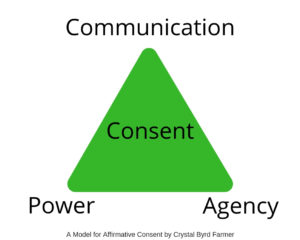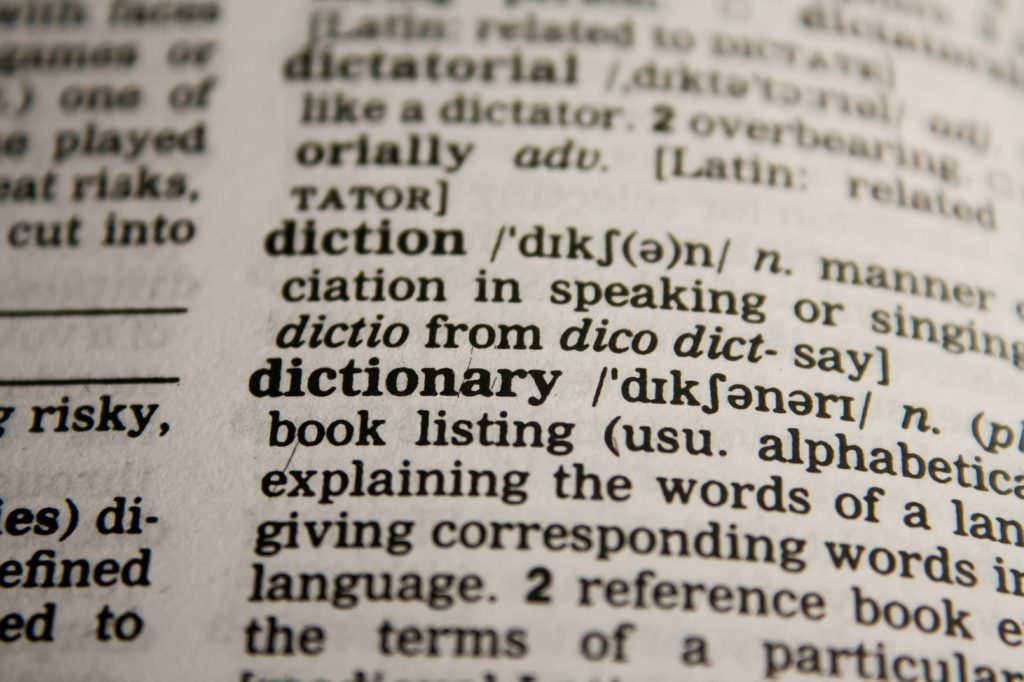The Triangle of Consent

Consent is an agreement between two people about how to move forward in a sexual relationship. While it’s easy to assume that obtaining consent is easy, American society has never created a space for people to learn how to obtain consent. What appears to be a simple issue of “yes” and “no” to sex often turns into “he said, she said” when someone makes an accusation of sexual assault.
So how do we improve our knowledge of how to handle consent? The sex positive community has not been a good example. In January 2018, Reid Mihalko, a well-known sex educator and cofounder of Cuddle Parties, was accused of of sexual harassment by a colleague. Though he later apologized and entered into a restorative justice process with other colleagues, his initial decision to not take responsibility shows a huge gap between his preaching about obtaining consent versus his actions.
Milhalko created an model for consent called the “safer sex elevator speech,” a way to establish boundaries and agreements before sexual activity. If a person who taught others how to obtain consent made a potential partner feel pressured, how can a regular person know what to do when consent gets messy?
I used to promote the safer sex elevator speech to people that want to know how to communicate about sex before the act. Once I learned about Mihalko’s behavior and his response, I started working on my own model. Who am I? I’m the website editor of Black & Poly, a community for black people transitioning to polyamory. I have been an assistant organizer for my local polyamory group and I am part of the sex-positive New Culture movement. I’ve taught others about consent and I am a survivor of sexual abuse. I identify as a womanist and I believe everyone wants to get this right.

This consent model expands the elevator speech beyond the basics of who, what, and how. It starts with the recognition of agency and power balances and ends with specific communication about sexual acts. This model has the form of a triangle in equal relationship to each other. If one part is missing or abbreviated, it will affect the entire experience of giving and obtaining consent. Here are the three legs: agency, power, and communication. I’ll break down each leg in detail.
Agency
The first leg is agency, which is the recognition that we all have the ability to make choices for ourselves. We make those choices based on available information and our own judgment. When we’re in a relationship, disclosing relevant information is the way we recognize our partner’s agency.
For instance, a person in the dating scene may tell a potential partner that they are seeing others. For those currently in a relationship, it may mean telling a partner that they have acquired an STI. This information usually affects the partner’s future actions, which is why it’s difficult and sometimes embarrassing to talk about. When we withhold information, we are taking away some of our partner’s agency. When a partner has the right information, they can respond in a way that will protect their own safety and peace of mind.
Another part of agency is cognition, or each person’s ability to understand the situation. Children, teenagers, and even young adults do not have the brain development of mature adults; it’s why we restrict drugs, alcohol, and driving by age. In the same way, neurodiverse people often lack the social awareness that will give them the information needed to give or obtain consent. For all people, impairment due to drugs and alcohol means people may make different decisions than if they were sober.
When determining if your partner has agency, compare their individual development against what is expected of people the same age and disability status. If they are under the influence of drugs or alcohol, are they cognizant of the decision they are making and its possible effects? Recognizing our partner’s agency is a critical part of obtaining consent. We must also acknowledge that even when consent is asked for and given, their actions could cross legal and/or moral boundaries.
Power
The second leg of the consent triangle is the awareness of power. It’s no accident that the majority of celebrities called out for sexual assault and harassment in the #MeToo have been powerful white men. Men born in the US have been brought up in a culture of toxic masculinity that values aggressiveness, manipulation, and dishonesty in order to “get the girl.” When a potential partner refuses to consent, a man’s response of disappointment and even anger is seen as socially appropriate.
Men are not always the bad guys, though. Any relationship between two people is subject to a power imbalance when someone has more seniority, wealth, status, or social support than their partner. Women who pressure men into sex by using their “feminine wiles” are just as guilty of manipulation. The power dynamics of each relationship is not fixed, and it’s always subjective. If someone believes they have less power, that will impact their ability to give consent.
In order to move forward with consent, people should acknowledge the power they hold in the situation. Have they considered the reasons their partner might say yes besides an actual desire to engage? Are they using their position or cultural privilege to get the sex they want? Can they give their partner the space to say no without fearing the consequences?
The fear of rejection is a powerful motivator during consent conversations. Saying or hearing “no” can be painful no matter how justified they are. In fact, many people go through with sex they are not sure about because the idea of hurting their partner seems to be worse than grinning and bearing it. To counter this, sex educators have asked people to ask for enthusiastic consent: it’s either a “Hell, yes!” or it’s a “no.”
Consent is almost meaningless when one partner has created a power imbalance through coercion and violence. People evaluating consent from the outside cannot use someone’s failure to stand up to or leave their abuser as a sign of consent. In the same way, it can be difficult to tell if a situation is sexual harassment or not. We can only start by believing the accuser and looking for patterns in each person’s behavior as it relates to the power balance.
Communication
The final leg of consent is the actual communication. Even in romantic comedies where the couple is falling over each other to get in a bed, consent has to be asked for and given. In an ideal world, progressively more intimate activities are verbally consented to by each partner. In the real world, it looks more like shy touches, smiles, and other nonverbal communication. The problem is that some people will look back on those activities and know that at some point they were unwilling to continue.
The moment bad sex becomes something worse is when this unwillingness is glossed over, when one partner notices that something is wrong but continues anyway. We have all experienced the feeling of powerlessness when we give up our agency to another. Our consent is half-hearted, and the guilt can be overwhelming. If you’ve ever had that experience in a non-sexual situation, then try to act with compassion when you see your partner hesitating to give consent.
So what does a conversation about sex look like? It starts with the truth. “I want to be intimate with you.” Even if the phrase sounds awkward and perhaps unauthentic, I encourage you to go into even more detail. The initial yes should be followed up with a checklist of sorts to cover the entire spectrum of sexual activity. Consider the following areas:
- Dirty talk
- Kissing
- Touching genitalia and erogenous zones
- Penetration (genitals, fingers, toys)
- Oral sex
- Anal sex
- BDSM activities such as spanking and fetishes
In the spirit of recognizing agency, both partners should discuss any potential barriers to consensual sex. This includes:
- STIs and date of last testing
- Use of barriers (such as condoms or dental dams), what kind and where
- Current relationships and agreements
- Past sexual history
- Use of birth control or medical sterilization
- Medical conditions and other physical limitations
- Psychological limitations, history of abuse, and triggers
- Attitude towards sex and how it will affect the relationship moving forward
Practice communicating consent before you and your partner get to the bedroom. Over time, these conversations will become commonplace and easier. It’s understandable that not everyone can talk about these things without feeling embarrassed or nervous, but sex is not something to be done in the proverbial dark. The more openness you bring to the conversation, the less shame you will feel about doing one of the most human acts.
At the end of the day, consent is just one part of navigating relationships. Due to the legal and social change in the world, it’s more important than ever to find a way to give and obtain consent without shame and guilt. Recognizing each other’s agency, addressing power imbalances, and communicating consent is a great way to create space for the pleasurable experience that sex should be.
Examples
Now that we have a model of consent, let’s apply it to different situations.
Situation 1: A heterosexual couple has gone out on their first date and are now at the man’s house for a nightcap. The man, recognizing his power in this situation (it’s his house and his alcohol) tries to make the woman as comfortable as possible. He may offer her a drink and sit beside her, almost touching her in a way that is intimate but not forceful. Either may initiate sex by engaging in touching and other nonverbal signs.
In order to bring the triangle of consent into balance, they can do things differently. Either partner could demonstrate agency by speaking the truth about the situation: “I’m at your house and excited about connecting more with you.” “I know I invited you over, but I understand if you want to leave without us having sex.” They can also turn touching into communication by saying, “Can I give you a hug or kiss?” Creating an opening for communication gives both partners the space and time to get in touch with their desires and act from a place of enthusiastic consent.
Situation 2: Gay acquaintances have been drinking at a bar, and one partner is interested in making out. Both partners have been using their agency by flirting and talking during the night. They have the social skills to be able to interpret when their attention is no longer reciprocated. Either one can gain consent by verbally asking for a kiss.
No matter how encouraging a partner has been, direct communication establishes a starting point for consent that they can both point to later. It’s true that alcohol can interfere with judgment, and that people can still regret activities they consent to. The more time they spend talking about what they both want, they more likely they will look back on the situation with confidence.
Situation 3: A woman at a higher level in a company is flirting with a colleague. The woman can acknowledge her position of power by saying, “I know I’m in upper management at work, but I want us to be equals outside.” She can clarify what she wants by saying, “I’m flirting with you because I’m interested in a sexual relationship.” It is vital that she gives her partner space to say yes or no and to follow up with details. Instead of depending on innuendo and creating a potentially dangerous “he said, she said” situation, both people can consent to the interaction in a way that feels good. (It’s still possible that their relationship could violate company guidelines.)
The world of dating is often murky, and misunderstandings can be played up as humorous or treacherous. By incorporating the triangle of consent into your interactions, you can create a container of safety and awareness around sexual activity.
Bonus
https://www.dailymotion.com/video/x2zhh1l
Believe it or not, a children’s show has created a perfect scenario for talking about consent. In the show Steven Universe, Steven is a half-alien who has a human friend named Connie. In this episode, they realize that they can fuse together like the aliens can. Fusion is an analog of sex for the aliens, and the episode is a great representation about how consent works.
In this episode, Steven and Connie are enjoying themselves at the beach. They start dancing, which is how the aliens initiate a fusion. Steven recognizes his power and covers his eyes before asking Connie to dance. They both allows themselves to be vulnerable with awkward dance moves and giggles. When they fuse, they are able to enjoy the pleasure of being in sync with each other while recognizing that sometimes they are uncomfortable. After interacting with other characters in the show, they stop to check in. “Are you ok?” This simple question opens up space for both people to communicate their willingness to continue.
Later, at a dance party, Steven and Connie’s togetherness becomes downright uncomfortable. They stop dancing and wonder why it’s not fun. They are both willing to say that something is wrong, even if they can’t explain why. Whether we express it or not, we know what a no feels like. Many of us have also experienced the negative consequences of saying no. In the episode, the response to no included aggressive shaming and attempts to convince them that their no is not a real no. We can create a better consent culture when we recognize a no, stop, and enjoy our time with a partner at a level where we are both comfortable.
H/T to Gregory Avery-Weir for their breakdown of Alone Together.
Resource: What Consent Looks Like






Wonderfully written and I cant wait to show my partner this!